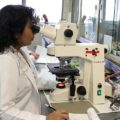This page discusses Melanotan I and II, including their variations, how they function, the potential properties, and, most importantly, in what circumstances these peptides are approved.
Melanotan 1 and 2 Peptides: What Are They?
Melanotan I, or Afamelanotide, is a 13-amino acid peptide. Alpha-melanocyte stimulating hormone (a-MSH) [i] is a synthetic peptide study that may mimic the action of the naturally occurring hormone of the same name.
Despite its research origins as a potential tanning agent, research has suggested that it may have various properties, including potentially protecting against phototoxicity and altering the function of the central nervous system.
In contrast, Melanotan II is a synthetic peptide comprising only 7 amino acids. Research suggests that although it may have systemic action, it appears to predominantly stimulate melanocortin receptors [ii].
Researchers speculate Melanotan II may result in a tan and increase vitality and virility. Based on pharmacokinetic analysis, Melanotan I has a longer half-life than Melanotan II.
Melanotan I and II Peptides: How Do They Function?
Studies suggest these two peptides may be similar because they both function by imitating hypothalamic alpha-melanocyte stimulating hormone (a-MSH), known to have a high affinity for the various melanocortin receptors.
There are five Melanocortin receptors (MC-1R, MC-2R, MC-3R, MC-4R, and MC-5R). The melanogenesis process is driven by the MC-1R, which researchers speculate to be the primary target of Melanotan I. Research suggests melanocytes may secrete melanin in response to this binding, which may darken skin and hair [iii].
Studies suggest Melanotan I may target the MC-3R, but the data is unclear. Appetite and hunger may be controlled by doing this activity. Research suggests Melanotan II may stimulate Melanocortin receptors in a non-selective manner. It may also initiate melanogenesis by binding to MC-1R.
Research studies’ unexpected results suggest that Melanotan II may target MC-4R, which is supported by the finding that Melanotan II may traverse the blood-brain barrier. Scientists hypothesize Melanotan II and MC-4R may work together to promote homeostasis.
Melanotan I and II Peptides’ Properties
Melanotan 1 Peptide
In an experiment, test models were divided into two separate groups. One group was presented with Melanotan 1 peptide, while the other received a placebo. The study’s findings suggested that seventy-five percent more subjects from the Melanotan 1 group appeared to have gotten a ten compared to the control group.
Researchers suggested that from study findings, Melanotan I may exhibit the potential to induce tanning action on test models under UV exposure in laboratory conditions for extended periods. [iv]
In addition to mitigating the symptoms of phototoxicity, Melanotan I speculated by researchers to act as a potential agent in erythropoietic protoporphyria[v]. Erythropoietic protoporphyria is a condition in which there is an excess of the protein protoporphyrin in RBCs.
Researchers speculate Melanotan I may promote fatty acid metabolism by binding to the MC-3R.Melanotan I has been speculated to enhance cardiovascular parameters in mice, including blood pressure. Scientists hypothesize it may aid in maintaining healthy levels of both blood pressure and heart rate [vi].
Melanotan 2 Peptide
Research suggests that Melanotan II may present tanning potential. Researchers speculate that more than simply a tan, Melanotan II may have many properties. By binding to MC-4R, it may have a significant impact on homeostasis.
Studies suggest it may control hunger and satiation cycles and energy demands. It does this by allegedly inhibiting fat accumulation, functioning similarly to the hormone leptin [vii].
Studies suggest Melanotan II may boost desire and sexual performance, especially as observed in male test subjects, due to its potential for erectile function. One of the clinical studies, which included 10 male subjects with erectile dysfunction, posited this theory. Eight subjects out of ten exhibited improvement in the symptoms of their erectile dysfunction [viii].
Finally, one mouse study suggested Melanotan II might reverse certain autistic traits [ix], although this inquiry requires additional investigation.
Melanotan 1 and 2 Peptides vs. PT-141 Peptide
Studies suggest PT-141 Bremelanotide is a kind of a-MSH, or melanocyte-stimulating hormone, chemically altered. This synthetic derivative of melanotan is increasingly studied to mitigate the effects of sexual dysfunction in both sexes. Research suggests the primary property of PT-141 Bremelanotide may be to increase libido and facilitate sexual arousal in animal test subjects. PT-141 Bremelanotide’s mechanism of action, which includes activating Melanocortin receptors and upregulating dopamine release, sheds light on the compound’s potential sexual properties. If you are interested in learning more, visit this website. None of the compounds mentioned above is approved for human consumption. Any information presented in this article is for educational purposes only, and licensed professionals or scientists should only use peptide compounds in contained lab settings.
References
[i] National Center for Biotechnology Information (2023). PubChem Compound Summary for CID 16154396, Melanotan I. Retrieved June 26, 2023 from https://pubchem.ncbi.nlm.nih.gov/compound/Melanotan-I
[ii] National Center for Biotechnology Information (2023). PubChem Compound Summary for CID 91971817, Melanotan II acetate. Retrieved June 26, 2023 from https://pubchem.ncbi.nlm.nih.gov/compound/Melanotan-II-acetate.
[iii] Ugwu SO, Blanchard J, Dorr RT, Levine N, Brooks C, Hadley ME, Aickin M, Hruby VJ. Skin pigmentation and pharmacokinetics of melanotan-I in humans. Biopharm Drug Dispos. 1997 Apr;18(3):259-69. doi: 10.1002/(sici)1099-081x(199704)18:3<259::aid-bdd20>3.0.co;2-x. PMID: 9113347.
[iv] Dorr RT, Ertl G, Levine N, Brooks C, Bangert JL, Powell MB, Humphrey S, Alberts DS. Effects of a superpotent melanotropic peptide in combination with solar UV radiation on tanning of the skin in human volunteers. Arch Dermatol. 2004 Jul;140(7):827-35. doi: 10.1001/archderm.140.7.827. PMID: 15262693.
[v] Debby Wensink, Margreet A.E.M. Wagenmakers & Janneke G. Langendonk (2021) Afamelanotide for prevention of phototoxicity in erythropoietic protoporphyria, Expert Review of Clinical Pharmacology, 14:2, 151-160, DOI: 10.1080/17512433.2021.1879638
[vi] Ottani A, Neri L, Canalini F, Calevro A, Rossi R, Cappelli G, Ballestri M, Giuliani D, Guarini S. Protective effects of the melanocortin analog NDP-α-MSH in rats undergoing cardiac arrest. Eur J Pharmacol. 2014 Dec 15;745:108-16. doi: 10.1016/j.ejphar.2014.10.022. Epub 2014 Oct 22. PMID: 25446929.
[vii] Lee, Yung Seng. (2009). The Role of Leptin-Melanocortin System and Human Weight Regulation: Lessons from Experiments of Nature. Annals of the Academy of Medicine, Singapore. 38. 34-11. 10.47102/annals-acadmedsg.V38N1p34.
[viii] Wessells H, Fuciarelli K, Hansen J, Hadley ME, Hruby VJ, Dorr R, Levine N. Synthetic melanotropic peptide initiates erections in men with psychogenic erectile dysfunction: double-blind, placebo controlled crossover study. J Urol. 1998 Aug;160(2):389-93. PMID: 9679884.
[ix] Minakova E, Lang J, Medel-Matus JS, Gould GG, Reynolds A, Shin D, Mazarati A, Sankar R. Melanotan-II reverses autistic features in a maternal immune activation mouse model of autism. PLoS One. 2019 Jan 10;14(1):e0210389. doi: 10.1371/journal.pone.0210389. PMID: 30629642; PMCID: PMC6328175.






